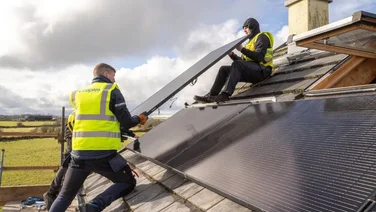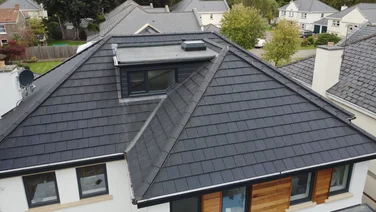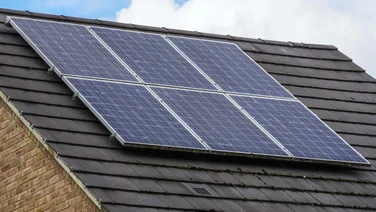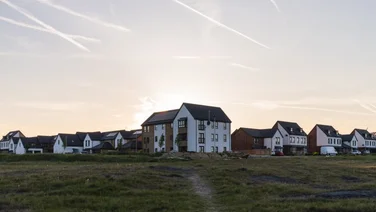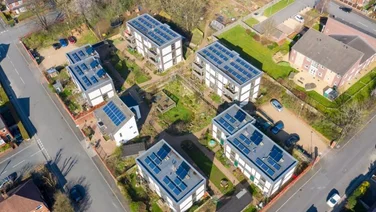- Can you put solar panels on balconies?
- The pros and cons of balcony solar panels
- How are solar panels on balconies installed?
- How much do balcony solar panels cost?
- How much money will balcony solar panels save you?
- Is your property suitable for balcony solar panels?
- Next steps
- Balcony solar panels: FAQs
✔ Plug-in solar panels are a popular option for balconies
✔ They don’t require professional installation and can be easily removed
✔ Plug-in solar panels generally cost between £100 and £600
Balcony solar panels cost less than roof-mounted ones if you opt for a plug-in model, which is the preferred option for most balcony set ups.
In this article, we’ll take you through the various ways to use solar panels on balconies, how well they work, and how much they cost. We’ll also let you know what balconies are suitable for them.
Want to get solar panels professionally installed on your roof instead? Just fill in our short form, and we’ll pass your details along to our network of installers. They’ll be in touch with tailored quotes.
Where do you want to install solar panels?
Get started
Can you put solar panels on balconies?
Yes, you can put solar panels on balconies. However, most balconies aren’t large enough to fit the number of solar panels needed to power a house or an apartment.
That’s why most people opt to use plug-in solar panels, also called portable solar panels, on balconies.
These types of panels don’t require professional installation. They can be used alongside a portable solar battery, as part of a solar generator system – like the kind people use on camping trips – and some models can be plugged directly into the home’s electrical sockets.
You can also install vertical solar panels on the balcony railing that are connected by a professional to the electrical mains. But these types of installations are expensive, so they might not be worth the investment, given the limited space available on most balconies.
Do solar panels on balconies still work well?
Solar panels on balconies can work well, as long as nothing is obstructing light from reaching the panels.
For example, balcony walls, nearby trees, or buildings can cast a shadow on the solar panels and reduce their electricity output.
The angle and direction the solar panels will also affect their output. In the UK, ideally solar panels should be between a 20° and 50° angle, facing southwards. This exposes the panels to the most amount of sunlight, and more sunlight means more electricity.
Angling a portable solar panel is usually quite easy, since they often come with adjustable stands or holders. This might not be possible if the panels are being suspended from the balcony railings.
If you have a balcony that faces east, west, or north, the solar panels won’t generate as much electricity as they could on a south facing balcony. North-facing panels in particular will be exposed to the least amount of sunlight.
The pros and cons of balcony solar panels
- They let people who can’t have a roof-mounted system use solar power
- They don’t always require professional installation
- They’re less expensive than roof-mounted systems
- The angle of the panels can be adjusted to capture more hours of sunlight
- Most balconies can’t fit more than one or two solar panels
- Balcony solar panels won’t generate as much electricity as large roof-mounted systems
- The panels take up space on a balcony that could be used for leisure
- Plug-in solar panels can’t feed electricity directly into the home’s electrical system
Advantages of balcony solar panels
The main advantage of balcony solar panels is that they allow people – generally those living in flats or rental accommodation – who can’t install solar panels on their roof to use free solar power.
Plus, since plug-in balcony solar panels don’t require professional installation, they can be set up and taken down easily, and at no extra cost. This makes them a great option for renters.
The DIY aspect of plug-in balcony solar panels also means that they’re less expensive than roof-mounted systems.
Lastly, if the balcony solar panels aren’t fixed to ramps or hooks to the railing of the balcony, their angle can be adjusted to follow the angle of the sun in the sky. This allows them to capture more sunlight and generate more electricity.
Disadvantages of balcony solar panels
The main disadvantage of having solar panels on a balcony is that you can’t fit as many solar panels on a balcony as you could on a roof. People with particularly large balconies might be able to fit two 400 watt (W) panels, whereas the average roof will fit 10 350 W panels.
Fewer panels also mean less electricity being generated. Most homeowners won’t be able to power their whole home with balcony solar panels.
Another disadvantage of balcony solar panels is that, depending on the set-up, they take up most of the balcony – one panel is around two square metres. You can free up space on the balcony if you opt to hang the solar panels from the balcony railings or wall.
Lastly, in the case of plug-in balcony solar panels, most models won’t feed the electricity they generate directly to the home’s electrical supply. To use the energy they generate, you need a portable solar battery, which will add to the overall costs.
Luckily, portable solar batteries are often sold as part of a solar generation package alongside portable solar panels.
Where do you want to install solar panels?
Get started
How are solar panels on balconies installed?
Plug-in solar panels on balconies do not need to be installed by a professional.
The solar panels just need to be propped up on the balcony, or suspended from the balcony railings, in an unobstructed spot that receives direct light.
To use the electricity they generate, the panels either need to be connected to a solar generator, or plugged into an electrical socket. Most plug-in solar panels come with charge controllers and mini-inverters.
The charge controller controls and regulates the flow of electricity, while the inverter converts the direct current (DC) electricity the panels generate into alternating current (AC) electricity, the kind used by electrical appliances.
Solar generators will typically have outlets, where electrical appliances and devices can be plugged in.
How much do balcony solar panels cost?
Plug-in balcony solar panels cost anywhere from £100 to £600.
Getting a portable solar battery will add another £200 to £600 to the overall cost of a portable solar power generation system.
These two devices are often sold as part of solar generation kits, which can include multiple portable solar panels and a solar battery. The price of these can go up to over £2,000 for kits that include high-capacity solar panels and solar batteries.
Installing balcony solar panels that are connected to the home’s electrical system costs around £1,405 for two 350 W panels – most balconies won’t have room for more than this.
Are there any grants for balcony solar panels?
There are no grants for portable solar panels. However, there are grants for residential solar panel installations – the kind that are connected to the home’s electrical system.
If you choose to get solar panels professionally installed on your balcony, you could be eligible for grants such as ECO4 or the Warm Homes Local Grant. Both these grants are available for low-income families or those receiving certain benefits.
Prior to March 2025, you could also have taken advantage of the Home Upgrade Grant, but this is now defunct.
You can read about all the existing solar panel grants on our page.
How much money will balcony solar panels save you?
One 400 W plug-in balcony solar panel could save you around £80 a year on electricity bills.
This is considerably less than the £483 a year that a 3.5 kilowatt (kW) roof-mounted solar panel system could save you. But then again, you can fit far fewer panels on a balcony than on a roof.
The amount of money you save will also vary depending on the size of the solar panel, and the amount of sunlight it’s exposed to throughout the year.
Larger solar panel systems produce more electricity, and so will save you more.
The weather will also affect how much electricity a panel produces. On cloudy days, solar panels produce 24% to 67% less electricity. So, in a year with particularly bad weather, you might save less money.
Is your property suitable for balcony solar panels?
Your property might be suitable for balcony solar panels if you are unable to install any on the roof, or in the grounds of your property.
This could be the case if you rent, or own an apartment, or if your roof is structurally unstable.
However, if you are a homeowner with a structurally sound roof, or a large plot of land around your property, you might want to consider getting a large roof or ground-mounted solar panel system that’s connected to the house’s electrical system.
These types of systems cost more, but they can also save you a lot more money – around £537 a year with the Smart Export Guarantee (SEG).
Is your balcony suitable for solar panels?
For a balcony to be suited for solar panels, it needs to be at least one metre long, and one metre wide. This is the minimum amount of space needed to fit the average plug-in solar panel.
Additionally, the balcony should not have a thick or opaque railing – such as one made of stone or brick – as this will block direct light from reaching the solar panels.
If this is the case, you could try propping the solar panel up on a raised platform, such as a box, or hanging them from the balcony railing, to expose it to more light.
If a balcony is under heavy shade, either from nearby buildings or surrounding trees, it might also not be suitable for solar panels, as this will limit the amount of direct light the panels receive.
Lastly, the balcony should ideally face south, or at the very least east or west. South-facing balconies receive the most hours of sunlight, allowing panels to produce more electricity than if they faced in another direction.
Solar panels on east or west facing balconies will benefit from direct sunlight in the morning or afternoon respectively, so they are still viable.
However north-facing balconies receive very little direct sunlight, so the solar panels will not produce as much electricity as they could if they were facing in another direction.
Next steps
Plug-in balcony solar panels can be a great option for people living in flats or rented accommodation.
They aren’t as expensive as regular roof-mounted systems, and they can still save you a little on your electricity bills.
If you’d rather get solar panels professionally installed, we can help. Pop a few details into our form, and we’ll pass them onto certified solar panel installers. They’ll reach out to you with their best prices.
Balcony solar panels: FAQs
Do you need planning permission for balcony solar panels?
In most cases, you do not need planning permission for balcony solar panels, whether you are putting plug-in solar panels on the balcony, or getting a professionally installed solar panel system.
The exceptions to this are listed buildings or ones in conservation areas. The owners of these buildings need to apply for planning permission before making changes to their outward appearance, such as when installing permanent solar panels – the kind that are connected to the home’s electrical system.
Can you put solar panels on a block of flats?
Yes, you can put solar panels on a block of flats. However, solar panels on flats are usually shared systems that supply electricity to multiple flats, and not one individual flat.
In most cases, individual flat owners will not be able to install solar panels solely for themselves, since they do not own the entire block of flats.
You can find out more by going to our page on solar panels for flats.
Can you put solar panels on an outbuilding?
You can put solar panels on an outbuilding, but you need to make sure the building’s roof is strong enough to withstand the weight of the solar panels.
For context, wooden outbuildings can typically withstand 6–7 kilograms (kg). This is less than the average weight of a standard solar panel, which is 18 kg. Flexible solar panels, which only weigh 1-2 kg, are a better option for outbuildings.


